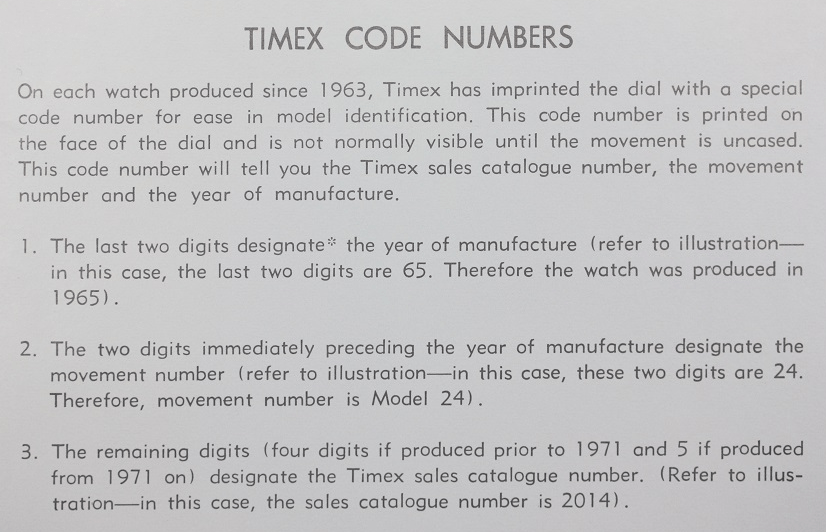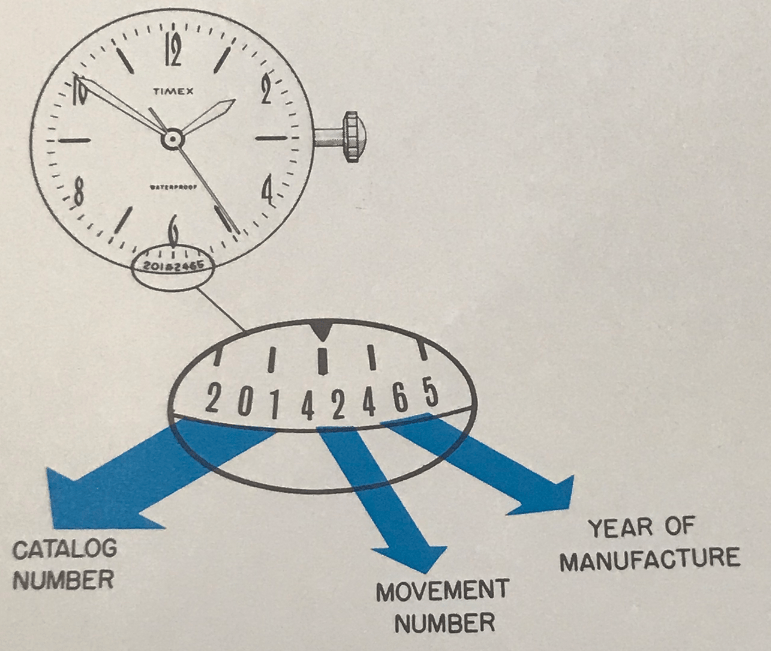Dial Codes
On a majority of vintage Timex watches you can identify the model name and more from a code printed on the dial. This is usually to be found at the bottom of the dial, but can also be printed at the top. If you are not able to see the dial code through a magnifier, loupe or using zoom on your phone’s camera, the dial code could be hidden under the watch’s bezel. This would require the removal of the dial from the case to reveal the code.
This is especially useful when browsing online auctions as in order to increase the price of a piece sellers often label every item as a Marlin. Asking for the dial code is the quickest way of find the actual model.
Rather than disassemble the phone from the back, it is often easier to use a crystal lift to take the perspex “glass” from the face of the watch and carefully remove any retaining ring. From there you should be able to see a dial code.
WARNING the ring is held in place with the crystal and could detach and bend the hands on the dial.
You can of course do the same by removing the case back and crown. This often lets you access the dial and movement assembly in one piece in order to see the dial code. On some models only crystal access or access through a seam in the edge of the case is possible where there is no case-back or the case-back aperture is too small to remove the movement assembly.
The image at the top and bottom of this post was taken from the official Timex service manual and gives you a basic guide to identifying things like model number, movement caliber and date of manufacture.

Model identification
| Number | Details |
| 1st & 2nd digits | Model/Series |
| 3rd digit | Case/Bezel color |
| 4th digit | Sweep/non-sweeping second hand with plain or radiolite dial |
| 5th digit | Band/Strap |
| 6th & 7th digit | Movement |
| last 2 digits | Year of manufacture |
First 2 digits denote the model or series name
| First 2 Numbers | Model Identification |
| 10 | Mercury, Monroe, Petite |
| 12 | Darwin, Timex 100 (non waterproof from 1959) |
| 20 | Marlin, Timex 100 (waterproof) |
| 21 | Timex 100 (waterproof from 1960) |
| 25 | Sportster |
| 30 | Character |
| 40 | Viscount (automatic/Self-wind) |
| 50, 52, 57 | Cavatina |
| 51 | Cavatina, Super Thin, High Fashion (1959) |
| 53 | Cavatina, High Fashion (1961) |
| 54 | High Fashion (1961) |
| 60 | Timex 400 |
| 65 | Timex 21 (decorated 21 jewel movement) |
| 68 | Timex 21 Self-Wind (decorated 21 jewel automatic movement) |
| 90 | Timex Electric |
3rd digit denotes the color of the bezel/Case
| Chrome Plated | Yellow (Gold) |
| 1 | 0 |
| 3 | 2 |
| 7 | 4 |
| 9 | 6 |
| – | 8 |
The 4th digit denote the presence or lack of a sweeping seconds hand with a plain or lumed radio-lite dial
| Type | Digit Reference |
| Sweep Plain | 4, 6 |
| Sweep Radiolite | 7 |
| No Sweep Plain | 0 |
| No Sweep Radiolite | 3 |
The fifth digit denotes the type of strap or bracelet used
| Digit | Type |
| 1 | Leather, suede or cloth strap |
| 2 | Full or partial metal expansion band |
| 4 | Cord |
| 4 | 1 piece bezel and band for the Fashion line |
| 6 | Solid bangle |
As an example a 20242 2469 would be a Marlin, Gold Case, Sweeping seconds hand with plain dial, on a metal band, with an M24 manual wind no date movement produced in 1969.
Rule of Thumb
Although not 100% accurate, if your caught short and need to figure out a watches model without access to the catalogs/brochures then the following is a quick way of figuring out exactly what model of Timex you have.
Dial codes starting with 10
These are usually Mercury/Monroe/Petite/Sprite models.
A Timex Mercury will not have “waterproof” or “water resistant” on the dial.
Timex Sprite cases are usually smaller and may include “waterproof” or “water resistant” on the dial.
These are usually manual wind and can be found both with and without a date or month window.
Dial codes starting with 12
These are non-waterproof Darwin and Timex 100 pieces from 1959
Dial codes starting with 20
These are usually Timex Marlin and waterproof Timex 100 models and will some times have “waterproof” or “water resistant” on the dials. These are usually manual wind models and can be found both with and without a date or month window.
Dial codes starting with 21
These are waterproof Timex 100 models from 1960
Dial codes starting with 25
These are Timex Sportster models.
Dial codes starting with 30
These are Timex Fun Timer, often called character models.
Dial codes starting with 40
These are usually Viscount models and will usually have a hybrid automatic/manual wind movement. These will also usually have the word “automatic” or on earlier models “self wind” printed on their dials. These can be found with and without a day/month window.
Dial codes starting with 50
These are Cavatina models
Dial codes starting with 51
These are Timex Super Thin, High Fashion and Cavatina models from 1959
Dial codes starting with 52
These are Cavatina models
Dial codes starting with 53
These are Cavatina and High Fashion models from 1961
Dial codes starting with 54
These are high fashion models from 1961
Dial codes starting with 57
These are Cavatina models
Dial codes starting with 60
These are Timex 400 models
Dial codes starting with 65
These are Timex 21 Jewel models (see below)
Dial codes starting with 68
These are self-wind (automatic) Timex 21 models
Dial codes starting with 90
These are Timex Electric models – These are not something i collect or will be covering here unless anyone wants to contribute something?
Other indicators
21 printed on the dial
This identifies these pieces as having an in-house jeweled movement in the 21J series. These pieces can be found with and without a day/month window.
100 or 400 printed on the dials
Having the numbers 100 or 400 printed on the dial identifies these pieces as 100 or 400 models. These pieces use outsourced jeweled movements and can be found with and without a day/month window.
Dog-Leg lugs
There is also a model called the J series, not to be confused with the 21j jeweled movement range. These J series pieces have a distinct dog-leg lug
